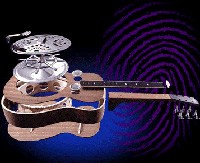

1. Save up your penneys and have your guitar "set up" to your playing style by a professional luthier or guitar technician. The difference in playability can be astounding. Even brand-new guitars often need this set up. You see, there is no such thing as a single perfect setup. Heavy players generally want a higher action. Lighter players want a lower action. A setup can make the difference between a really good instrument and an excellent one and can vastly improve even a mediocre one. The cost? Probably somewhere between $100-200. MORE
2. Click HERE for info on how to optimize your truss rod setup.
3. Always store your guitar IN ITS CASE to protect it from climatic changes and physical damage.
4. The proper range of humidity for your guitar is forty to sixty percent. Below or above that will affect the neck relief and the curvature of the guitar's table. Extremes of low humidity can cause the fret ends to "sprout" from the edges of the neck and can cause finish splits. There are many small hydrometers (humidity meter) available on Amazon which will fit inside your case. Many will show the current readings and a high and low historic record.
5. If you live in a dry area or keep your house very dry, most manufacturers suggest you store your acoustic guitar with a sound-hole humidifier to prevent the woods from drying up. As an alternative, or in a "humidity emergency", you can put a damp but wrung-out sponge in a partially open zip-lock bag, wrap that in a wash cloth, and place it in your case.
6. Here are some hints for boosting humidity in the winter: If you have an electric clothes dryer, fill a bucket about halfway, disconnect your flexible dryer vent hose from the wall, and aim the hose into the bucket. When you run the dryer, the water catches the lint and the warm, humidified air fills your home. A warm shower with the doors open and the blower off can also help boost the humidity.
7. How about a popular dorm humidifier for fall and winter? Go HERE
8. Guitars with nitro-cellulose finishes can be damaged by the rubber pads on many guitar stands. The rubber puts out gaseous chemicals which attack the finish. Either buy stands specifically designed to protect these finishes or create a cotton "glove" from T-shirt material to go around the rubber pads.
9. Guitars with nitro-cellulose finishes can also interact with your bodily chemistry so that the finish becomes "tacky", and makes it hard to slide on the neck. I've found this to be true in my case especially when I'm nervous. That really helps the first song of the night along! I can't really offer a solution for this, but can tell you that guitars with polyurethane finishes don't have this problem.
10. Here's a way to repair speaker cone tears with only the front of the speaker accessable: First, create a tool by bending the last 16th of an inch of the point of a pin to a right angle from the shaft. Now put a nice CD on the stereo. Apply carpenter's wood glue generously to the back and edge of the non-flexible side of the tear with a toothpick. Using your new tool to reach behind the flexible side of the tear, bring the lips of the tear together. Relax and hold them together with your tool while listening to the nice CD until the glue cures (about twenty minutes).